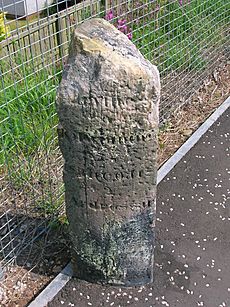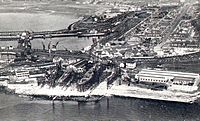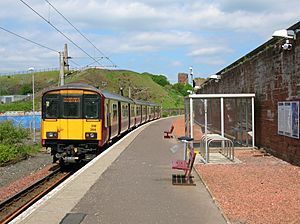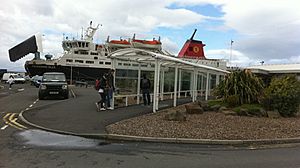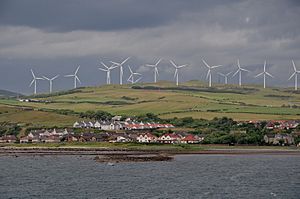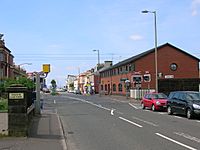Ardrossan facts for kids
Quick facts for kids Ardrossan
|
|
|---|---|
| Town | |
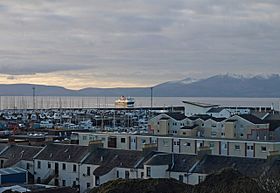 Ardrossan skyline and overlooking Ardrossan Harbour, January 2008 |
|
| Population | 10,500 (2020) |
| OS grid reference | NS232424 |
| • Edinburgh | 79.1 miles (127.3 km) |
| • London | 432.3 miles (695.7 km) |
| Council area | |
| Lieutenancy area |
|
| Country | Scotland |
| Sovereign state | United Kingdom |
| Post town | ARDROSSAN |
| Postcode district | KA22 |
| Dialling code | 01294 |
| Police | Strathclyde |
| Fire | Strathclyde |
| Ambulance | Scottish |
| EU Parliament | Scotland |
| UK Parliament |
|
| Scottish Parliament |
|
Ardrossan ( from the gd: Àird Rosain meaning "headland of the small promontory") is a town on the North Ayrshire coast in southwestern Scotland. The town has a population of 10,670 and forms part of a conurbation with Saltcoats and Stevenston known as the 'Three Towns'. Ardrossan is located on the east shore of the Firth of Clyde.
Contents
History
Ardrossan's roots can be traced to the construction of its castle 'Cannon Hill', thought to be in around 1140, by Simon de Morville. The castle and estate passed to the Barclay family (also known as Craig) and through successive heirs until the 14th century when it passed to the Eglinton family on the death of Godfrey Barclay de Ardrossan, who died without an heir. Sir Fergus Barclay, Baron of Ardrossan was said to be in league with the Devil and in one of his dealings, set the task for the Devil to make ropes from sand; on failing to do so, the Devil kicked the castle with his hoof in frustration and left a petrosomatoglyph hoofprint.
The castle stood until 1648, when Oliver Cromwell's troops had it destroyed, taking much of the stonework to Ayr to build the citadel at Montgomerieston. The ruins of Cromwell's Fort still stand, but are overgrown and in a dangerous condition.
In 1759 the Earl of Eglinton formed a herd of the ancient breed of White or Chillingham cattle at Ardrossan, probably using stock from the Cadzow herd. The numbers dropped and in 1820 the remaining animals were dispersed. All the animals in the herd were hornless.
Ardrossan developed during the 18th and 19th centuries thanks to its position on the coast. Exports of coal and pig iron to Europe and North America were the main trade from the town's port, which became a centre for shipbuilding. Fishing vessels and small cargo boats were the mainstay of the shipyard until the 1950s, when the yard ceased to exist as a result of foreign competition. A smaller yard, McCrindle's, operated until the 1980s before it ceased trading.
Passenger services from Ardrossan harbour to Brodick on the Isle of Arran started in 1834, and services to Belfast in Ireland (later Northern Ireland) and the Isle of Man followed in 1884 and 1892 respectively. Clyde sailings were operated initially by the Glasgow and South Western Railway Company from Winton Pier and the Caledonian Railway from Montgomerie Pier. The Earl of Eglinton's ambitious plan for a canal link to Glasgow was never realised.
Between 1841 and 1848 Ardrossan was a part of the "West Coast Main Line" equivalent of its time. The fastest route from London to Glasgow was by train to Fleetwood, and then by packet boat to Ardrossan. After 1848 the entire journey could be made by rail, avoiding Ardrossan. The link to the Isle of Man no longer operates, having first been moved to Stranraer until all Scottish services terminated. Shell-Mex operated an [oil refinery] on behalf of the Air Ministry, from a World War II aviation-fuel canning factory, and the harbour was expanded for the company's tanker ships to berth. Residents blocked plans for further expansion of the refinery, limiting the operations that could be carried out there in the 1960s. Operations at Shell-Mex ceased in 1986.

The harbour has been redeveloped as a marina, and the passenger and vehicle ferry to Brodick is operated by Caledonian MacBrayne.
Ardrossan became a burgh, in 1846, with a provost, magistrates and commissioners. Its burgh status was lost in 1974 on the formation of Strathclyde Regional Council, when it came under Cunninghame District. It is now part of North Ayrshire, created as a unitary authority in 1996.
In 1921 Ardossan was the European site for the first successful reception of radio signals from North America. Using a frequency near 1.3 Megahertz an amateur radio group in Connecticut sent Morse code signals to a station set up in a tent.
Since 2006 Ardrossan has been part of a regeneration area, overseen by the Irvine Bay Regeneration Company. Its vision for Ardrossan is as a gateway to Arran and good place to live and relax next to the sea in a regenerated town centre serving the existing and incoming community. It has started to be achieved through renewal of the town centre, which includes a derelict office in Princes Street which has been turned into two modern shops. The former Jack Miller's Hotel building at 78 Princes Street an(ex Posthouse for changing horses in the 1800s), was refurbished in autumn 2010 and has been home to several businesses and including an art gallery and artists studio space called Phoenix, and a graphic design studio. The old pumphouse has been transformed into an Italian restaurant. In 2014 work started on new office accommodation beside the marina, with works due to be completed in summer 2015. The North Shore project includes the redevelopment of the oil refinery site and the extension of the marina.
Transport
Railway
The town has three railway stations: Ardrossan South Beach, close to the boundary with Saltcoats; Ardrossan Town, closed 1968 and reopened 1987; and Ardrossan Harbour near the port for the Arran ferry. Ardrossan South Beach station is at the junction on the Ayrshire Coast Line, where the lines to Ardrossan Harbour and Largs diverge. There are two trains per hour that head eastbound from Ardrossan South Beach to Glasgow Central, of which one comes from Ardrossan Harbour, calling at Ardrossan Town, and the other comes from Largs. All rail services from Ardrossan are operated by ScotRail.
There are two closed railway stations: Ardrossan North was adjacent to Montgomerie Street, and the platform remains can still be seen, although the redevelopment of the former Shell Bitumen Plant site edges closer to the remains. Ardrossan Montgomerie Pier was further down the line from Ardrossan North, but the building of the harbourside apartments removed the last remains of the platforms and no evidence remains that a railway station once stood there. The last train ran through these stations around 1968, although by that time they served summer boat train services only, after regular passenger traffic ceased in 1932.
Roads and bus services
Ardrossan is linked to Glasgow via the A737 road and to Ayr via the A78 road. The A78 Three Towns Bypass opened in December 2004 and has provided an improvement to local transport links, reducing local travelling times. The bypass has diverted heavier traffic from the Three Towns. Bus services to the town are operated primarily by Stagecoach West Scotland.
Ferry services
A regular ferry service from Ardrossan to Brodick on the Isle of Arran has run since 1834. The ferry departs every two hours and 45 minutes Monday–Saturday and takes 55 minutes. A ferry service to Campbeltown started on 23 May 2013.
In the past Ardrossan had ferry services to Belfast, and, in summer, to the Isle of Man. The Belfast run was operated by the Burns and Laird Line and its last scheduled service was in 1976. The last ship to sail the route was MV Lion, which was the largest car ferry to operate from Ardrossan. The Isle of Man run was operated by the Isle of Man Steam Packet Company during the summer season, and its last service was in 1985, however Caledonian MacBrayne experimented with a smaller vessel for a couple of seasons, which ran one return service per week.
Energy
Ardrossan is located near two nuclear power stations, Hunterston A nuclear power station, 360 Mega-Watt (MW) (currently being decommissioned) and Hunterston B nuclear power station, 1215MW. Ardrossan Wind Farm, a 24MW wind farm that opened in 2004, overlooks the town.
Religion
In Ardrossan, there are five churches. St.Peter-in-chains is a Roman Catholic church. Park Church is Church of Scotland. There is also the EU Congregational Church and the Church of the Nazarene. Barony St John's also used to be Church of Scotland but the congregation moved out of the building in 2011 with safety concerns and eventually united with Saltcoats: New Trinity church in November 2013 to form what is now called Ardrossan & Saltcoats Kirkgate Parish Church, with the Chapelwell Street premises in Saltcoats being retained for worship. The Barony St John's premises were sold in December 2014 to a charity proposing to run personal safety classes.
Culture
Ardrossan has some notable buildings, for example Barony St John's Church and St Peter-in-Chains Roman Catholic Church]. St Peter's is of modern construction in an all-brick, Swedish style. Its architects were Gillespie, Kidd & Coia. Barony St John's dates from the mid-19th century. Both buildings are on the South Crescent, overlooking South Beach and Irvine Bay. The crescent is lined by large villas dating from the 19th century, many of which have been converted into multiple residences.
Castlehill
Also known as 'Cannon Hill' by locals, it is a great place to visit, including a swing park. An historic ancient burial place on Castle Hill was vandalized in the 1950s. One tomb was taken to the Barony Church on South Crescent for safekeeping.
A prehistoric shell-mound, measuring 102 ft by 16 ft, on the side of Cannon Hill, close to Ardrossan Town railway station, was excavated by the Ayrshire historian John Smith in the 1890s. Its length was mostly overhung by a few feet, by the rock face, which had formed a rock-shelter, which the excavation showed had been occupied at intervals over a considerable period. The railway workings had cut a longitudinal section in the mound, which overlay a 1 ft layer of raised beach sand.
The mound was composed of seashells, mainly periwinkle and limpet, and animal bones. Relics found included a stone 'anchor' with a groove cut round it for a rope, a possible stone sinker, fragments of very coarse, hammer stone, hand-made pottery, also pieces of wheel-turned, glazed pottery, a bone chisel, two bone needles, etc. No sign of the mound is visible today.
Notable people
- Roy Aitken, footballer, captain of Celtic Football Club in the 1980s and captain of the Scotland national team
- Sam Black, artist
- Flying Officer Kenneth Campbell, recipient of the Victoria Cross
- Dugald Drummond, born in Ardrossan in 1840, was chief mechanical engineer with the Caledonian Railway
- Peter Drummond, was a senior executive for the Glasgow and South Western Railway
- Peter Duncan, former Shadow Secretary of State for Scotland
- Bobby Ferguson, goalkeeper for Kilmarnock in the 1960s.
- Billy Gilmour (footballer), professional footballer, former youth player of Rangers F.C, and currently Chelsea F.C.
- Calum Kennedy (1928–2006), popular exponent of Scottish Gaelic song in the 1950s and 60s
- John Kerr, physicist who discovered the now-eponymous Kerr effect.
- Campbell Martin, journalist and former Independent Member of the Scottish Parliament for West of Scotland
- Mark Menzies, Conservative member of parliament for Fylde
- Craig Reid, footballer
- W.B. Young, Scottish rugby player
- Paul Ireland, film director
Other places with the same name
The name Ardrossan has also been given to places elsewhere in the world:
- Ardrossan, South Australia
- Ardrossan, Alberta
- Ardrossan is the name of a large estate outside Philadelphia, owned by Robert Leaming Montgomery. His daughter, Helen Hope Montgomery Scott, was the inspiration for Tracy Lord, heroine of The Philadelphia Story.
Amenities
- Eglinton Country Park is linked to Ardrossan by the Sustrans Cyclepath.
Education
Ardrossan is served by three primary schools (St Peter's Primary School, Stanley Primary School, and Winton Primary School) and two secondary schools: Ardrossan Academy, a non-denominational school opened in 1882, has about 1,050 students from Ardrossan, Saltcoats, West Kilbride and Seamill; St Matthews Academy in Saltcoats is the secondary school for Roman Catholic pupils from Ardrossan.
Images for kids
See also
 In Spanish: Ardrossan para niños
In Spanish: Ardrossan para niños



